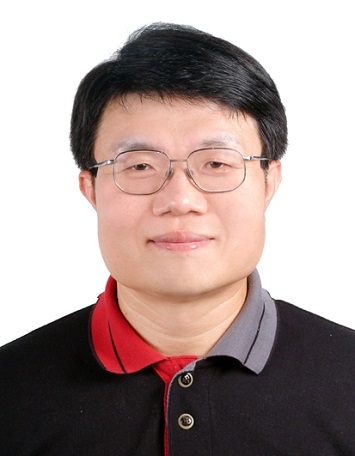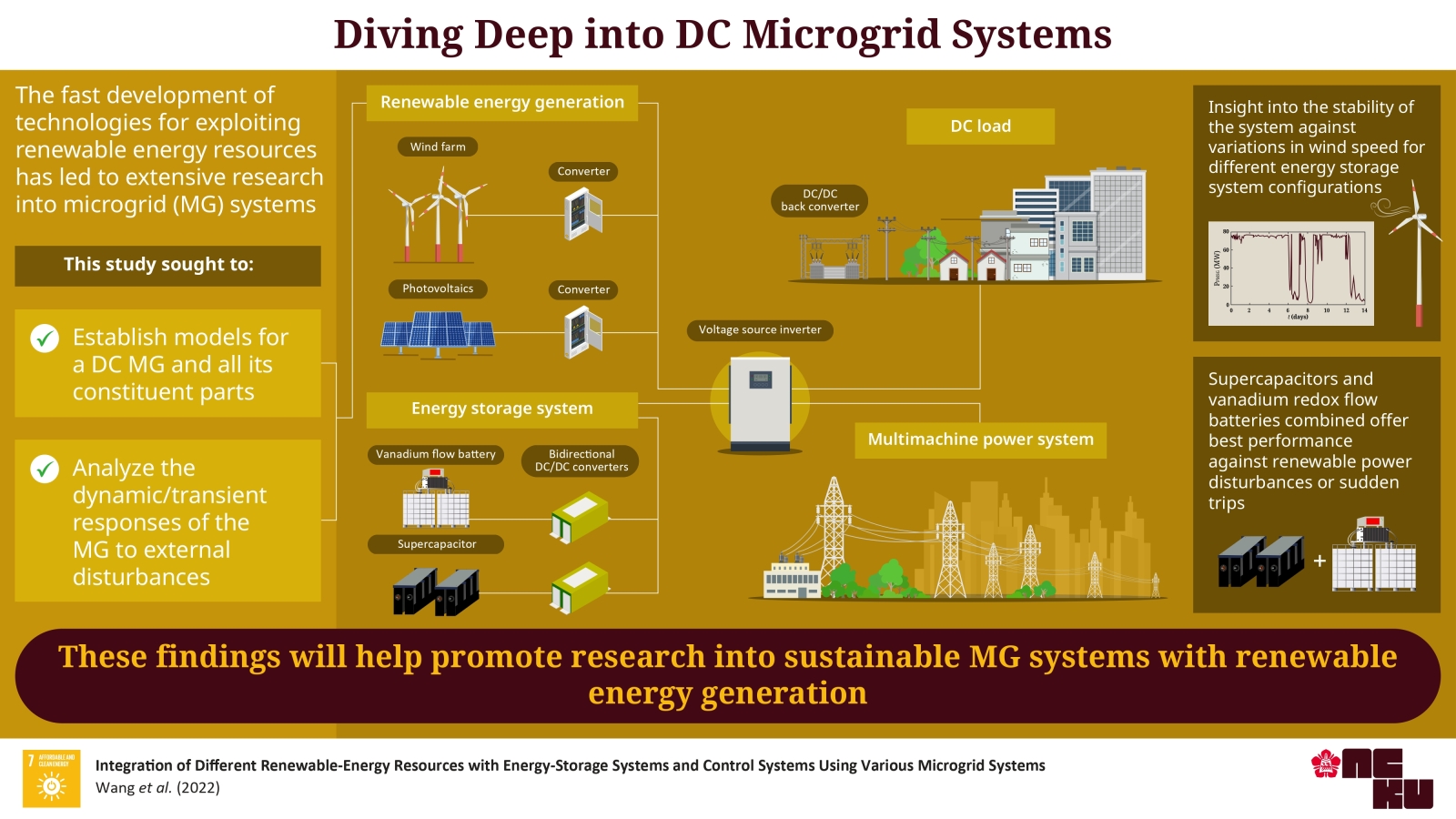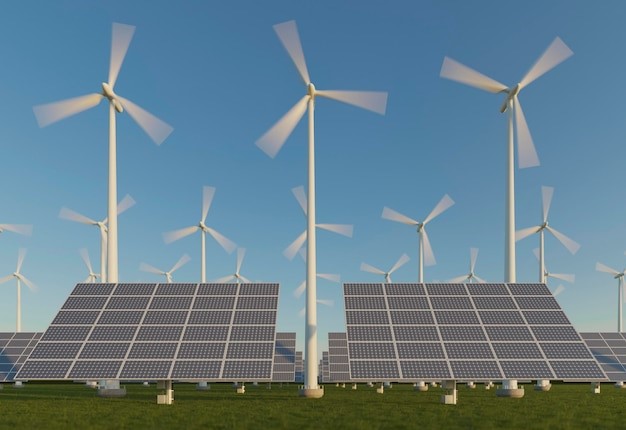


Integrating Renewable-Energy Resources and Hybrid Energy-Storage Systems via Microgrids
Connecting wind- and solar farms-based microgrids with a hybrid energy-storage system based on supercapacitor and flow battery to a power system
The intermittent and irregular power supply of renewable-energy resources necessitates the development of suitable energy-storage systems. In an Asia Sustainable Development Goals Group project, researchers in the Worldwide Universities Network have integrated wind and solar farms with a hybrid energy-storage system based on supercapacitor and flow battery and employed DC microgrids with control systems. While the hybrid energy-storage system can offer suitable compensation characteristics, future advancements will improve stability of the integrated system further.
The technologies for harnessing renewable-energy resources are rapidly progressing. They include wind, solar, tidal, biogas, hydro, geothermal resources, etc. However, their supplies are irregular and intermittent. It is thus necessary to integrate them with suitable energy-storage systems and control systems.
To this end, Professor Li Wang of the National Cheng Kung University in Taiwan has made great strides under an Asia Sustainable Development Goals (SDGs) Group project. It contributes towards the seventh SDG—affordable and clean energy for all. Prof. Wang works with international partners in the Worldwide Universities Network (WUN) and other prominent universities towards achieving sustainable energy solutions. His co-investigators include Prof. Dehong Xu of Zhejiang University, Prof. Hazlie Mokhlis of University of Malaya, Prof. Kein Huat Chua of Universiti Tunku Abdul Rahman, Prof. Manoj Tripathy of Indian Institute of Technology Roorkee, Prof. Thi Ha Nguyen of University of Connecticut, Prof. Mohammad Mahdi Farid and Prof. Alison Subiantoro of University of Auckland, and Prof. Kang Li, Prof. Benjamin Chong, Prof. Sadegh Azizi, and Prof. Amir Abiri Jahromi of University of Leeds.
The researchers have modeled various power-electronics converters to form an integrated system. Prof. Wang sheds further light. “Herein, large-scale wind and solar farms are joined to direct current, commonly called DC microgrids. These grids, in turn, get connected to a multi-machine power system through bidirectional DC-AC voltage-source inverters. The DC microgrid system consists of a hybrid energy-storage system based on supercapacitor and vanadium redox flow battery. Both are individually connected to the DC microgrid through bidirectional DC-DC converters.”
The researchers utilized control block diagrams with associated control algorithms for operating the power-electronics converters. Once the integrated system was established, they systematically evaluated its stability under various operating conditions. These included the studied system with no energy-storage system, only the energy-storage system based on supercapacitor, the energy-storage system based on flow battery, and the hybrid energy-storage system based on supercapacitor and flow battery.
During evaluation, the researchers first performed frequency-domain eigenvalue analysis. They recorded the root-loci plots of the studied system under increasing wind speeds from 4 m/s to 15 m/s, solar irradiation of 950 W/m2, and DC load of 0.05 per unit. A careful comparison showed that the studied system was stable under different wind speeds.
Next, the researchers performed time-domain dynamic and transient simulations under practical wind-speed and solar-irradiation disturbances. They also considered the sudden trip of wind and solar farms. The results revealed that the hybrid energy-storage system offered suitable energy-compensation characteristics for the proposed technology.
The researchers have published 12 academic papers as part of the project since July last year. They have also obtained funding for three further proposals. In the future, the project aims to explore the different aspects of related fields.
The research group will develop different control schemes for alternating current (AC) and hybrid AC/DC microgrid systems. Then, they will connect the grids with suitable energy- storage systems such as lithium-ion batteries, ultra-capacitors, flywheels, and superconducting magnets.
Likewise, there is a need for suitable control systems based on well-developed control theories and advanced strategies. The researchers can show their effectiveness via different methods. Power-flow analysis, damping characteristics, stability margins, frequency deviations, and voltage variations are some of them.
"These advancements shall maintain a good voltage profile and reduce frequency deviations under disturbance conditions. In effect, they will improve integrated system stability further under grid-connection and autonomous modes," concludes Prof. Wang.
Reference
|
Authors
Project name
Journal |
Li Wang1, Dehong Xu2, Hazlie Mokhlis3, Kein Huat Chua4, Manoj Tripathy5, Thi Ha Nguyen6, Mohammad Mahdi Farid7, Alison Subiantoro7, Kang Li8, Benjamin Chong8, Sadegh Azizi8, and Amir Abiri Jahromi8
Integration of Different Renewable-Energy Resources with Energy-Storage Systems and Control Systems Using Various Microgrid Systems
Asia SDGs Group Report |
|
DOI
Affiliations |
N/A
1National Cheng Kung University, Taiwan 2Zhejiang University, China 3University of Malaya, Malaysia 4Universiti Tunku Abdul Rahman, Malaysia 5Indian Institute of Technology Roorkee, India 6University of Connecticut, United States 7University of Auckland, New Zealand 8University of Leeds, UK |

Title: Energy-storage systems in solar and wind farms
Caption: In an Asia Sustainable Development Goals (SDGs) Group project, researchers in the Worldwide Universities Network (WUN) have integrated wind and solar farms with a hybrid energy-storage system based on supercapacitor and flow battery.
Source: Freepik
About Professor Li Wang
Professor Li Wang completed his Ph.D. in electrical engineering from National Taiwan University in 1988. He has undertaken 53 projects and published 268 papers over the last three decades. They have been cited nearly 5,000 times. His research interests include electric circuit analysis, electric machinery, industrial electronics, power electronics, power generation engineering, power systems, and renewable energy. He actively contributes towards the following Sustainable Development Goals: affordable and clean energy (SDG7), industry, innovation, and infrastructure (SDG9), and life below water (SDG14).